Popular games published by company North American Philips Consumer Electronics Corp.
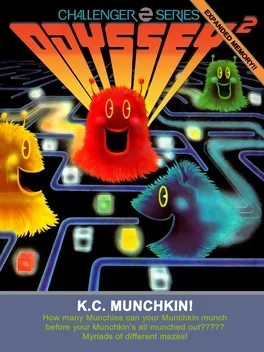
A copy of Pac-Man, but with various improvements. This game is primarily known for the Atari lawsuit against it which set an important precedent for copyright and lawsuits in videogames.
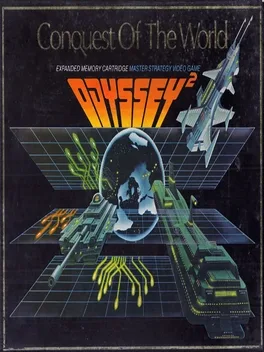
CONQUEST OF THE WORLD represents a significant departure from traditional game design. The components have been designed to provide you with a very realistic model of the real world to both electronically and graphically simulate strategic and tactical confrontation between world powers. Electronic land, sea and air forces can be deployed against each other in any combination and are totally dependent on supplies which are represented by energy units. The game board is a true-to-life model of the relationships between countries of the real world in the early 1980's. Forty-three countries have been divided into eleven "politectonic" or geo-political zones. Each country has been weighted with a power base figure that reflects its capability to persuade other nations to conform to its wishes - by diplomatic coercion or by direct military force. These figures are based on the formula created by Ray S. Cline, formerly Deputy Director of Intelligence for the C.I.A. Pp = (C+E+M)x(S+W) PERCEIVED POWER = (Critical Mass (Population + Territory) + Economic Capability + Military Capability) x (Strategic Purpose + National Will). Future shifts in world power and change in governments will - of course - make changes in these numeric weightings appropriate. Players can feel free to sustain realism by changing the numbers assigned to each country as life goes on. If you play other war games such as those published by Avalon Hill and SPI, you will find that the computer cartridge interfaces very effectively with them. The onscreen combats will generate much more excitement and realism than the usual dice provided to resolve conflicts. Onscreen energy units can be programmed into the computer to reflect the relative strength between different forces. The differential between the onscreen energy units at the end of each battle can also be applied to the combat results tables that come with these games. Conquest of the World is the first game of its kind, so be ready for many unusual features. Take the rules one step at a time and you will find it to be a fascinating game of endless challenge - which, once learned, is not at all difficult to explain to others. THE OBJECTIVE OF THE GAME is to lead your Homeland to world domination through negotiations, conquests and alliances. Each successful conquest and alliance you make will strengthen your country's power base. The country with the strongest power base at the end of the game is the winner.
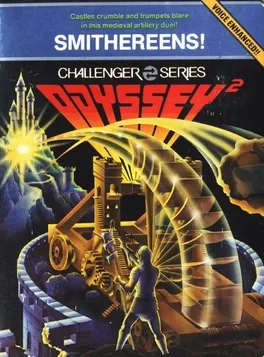
Stone Sling is the 20th official game released by Philips for the Videopac console. In the United States, it was sold under the title Smithereens! for the Magnavox Odyssey² console. The game allows for two player simultaneous gameplay where both players have a fortress as well as a catapult used to fire each other. With each hit the fortress' size decreases by a bit. However, sometimes if your aim is off, the catapult will miss the fortress and instead hit one of the opposing soldiers. Like other Videopac games, Stone Sling could not compete against Atari games, though the game did do well in Europe and Brazil.
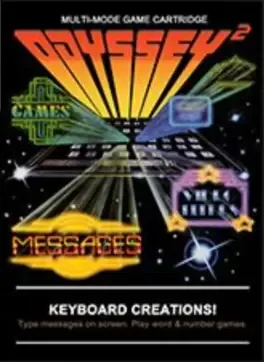
Keyboard Creations! lets the player type in a main message which will continually scroll across the screen. The game also lets the player set up an "alarm" message which can pop up every 30 seconds. The player can also set a digital clock to keep track of time.

For a normal ball action game, press 1, 2, 3 or 4 on the alpha-numeric keyboard for one, two, three or four players. For a slow motion game, press 5 for one player, press 6 for two players, press 7 for three players and press 8 for four players. Players 1 and 3 take turns using the right hand control unit. Players 2 and 4 alternate using the left hand control unit. To shoot, pull the joy stick back and release. The longer you hold the joy stick back, the greater the velocity of the ball. Audio beeps will indicate holding time. Push the action button to activate the flippers. Push the joy stick to the left to shift the flipper coverage to the left. Push right to shift flipper coverage to the right. Your game score will be automatically displayed at the far left of the scoreboard. Your bonus score will be displayed at the right side of the scoreboard. The bonus will automatically be added to you score at the end of each ball. The scoreboard will automatically show each player's score during the turn. 8,9 Roving Rebounds No effect on score. 1,2,3,4 Backfield Bonus Bumpers 4000 points each, disappear when hit. 6,7,10,11,12,13 Thumper Bumpers 100 points unless red, 500 points when red. 5 Bonus Box Scores randomly between 720 and 1350 each time hit. Bonus Bonus score is added to main score at end of each ball When bonus exceeds 5000 points, it is added to main score immediately; the bonus indicator is reset to 0 and the Backfield Bumpers 1, 2, 3 & 4 are restored and play continues. The winner is the player with the highest score for five balls. The scoreboard will automatically review each player's score at the end of the game. To play again, push RESET and then press the appropriate number on the alpha-numeric keyboard.
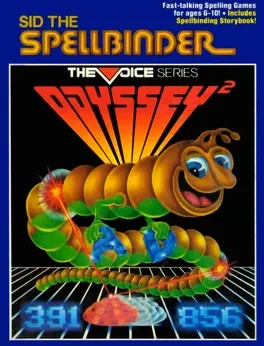
Press 0 on the numeric section of the keyboard. The Voice will ask you to "SELECT SKILL." Choose 1 or 2. Press 1 for the first skill level. Press 2 for the second skill level. (If you don't press either, the computer will automatically deliver skill level 2 after about 15 seconds.) The Voice will immediately announce: "MONSTER ATTACK! OPEN FIRE!" Sure enough! Giant Sid the Spellbinder snakes across the screen. Your only defense is a missile launcher at the bottom of the screen. Use the joystick of either hand control to move your missile launcher to the right or left. Press the action button to fire a missile. Your ammunition supply is indicated by the number at the lower right hand corner of the screen. You get thirty missiles at skill level 1 and twenty missiles at skill level 2. If you do not completely destroy Sid the Spellbinder before it reaches the opening at the lower left and right sides of the screen, it will eat your reserve missile supply starting with the second turn. Sid the Spellbinder consumes five missiles for each of its segments that make it to the opening. Your score appears at the lower left hand corner of the screen. Every segment you hit is worth progressively more points. The first segment you hit is worth 1 point. The second is worth 2 points. The third is worth 3 points - and so on up through ten. If your score is less than 200, Sid the Spellbinder will squeeze its remaining segments together when it goes off the screen. When your score goes over 200, the game gets harder. The gaps will remain open and Sid the Spellbinder moves faster and faster. The spelling fun starts when you hit all ten segments of Sid the Spellbinder - or when it reaches the bottom of the screen. - eats some of your missiles - but leaves you with some in reserve. The Voice will ask you to spell a word. Type in the letters on the alphabet section of the keyboard. If you make a mistake in typing, press CLEAR. When you think you have typed in the correct spelling, press ENTER. You get 10 missiles for every word spelled correctly at skill level 1. You get 5 missiles for every word spelled correctly at skill level 2. You will get a chance to spells three words in each round of the game. If you don't spell a word correctly the first time, the computer will ask you to try again. If you don't spell the word correctly on the second try, the computer will spell it for you so you'll know how to spell it next time. After each series of three words, Sid the Spellbinder will attack and try to eat your missiles. The game ends when you have no missiles left. To start a new game, press RESET and then press 1 (for skill level 1) or press 2 (for skill level 2).
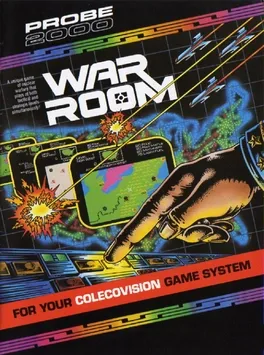
War Room is a action strategy game set in the Cold War conflict between the United States and Russia, which is escalating into a nuclear showdown. The player controls a satellite hovering above the USA, which are represented in a top down view. By destroying enemy satellites with his own satellite, the player has to prevent the destruction of cities in his territory and is able to score points. To keep his cities defensible, the player also has to collect supplies from those cities and distribute them accordingly. This is done by entering the cities with the satellite and collecting supplies in a action sequence. The game ends once all of the player's cities are destroyed.
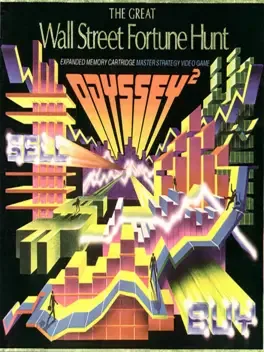
THE GREAT WALL STREET FORTUNE HUNT is an authentic computerized model of the real investment world. The opportunities for investment in the game represent the thousands of alternatives available on the various exchanges. You'll find conservative blue chips like IBM (International Business Machines Corporation) and high risk high flyers like WOW (Wildcat Oil Western). You'll find the fast food industry represented by McDonald's Corporation and high technology manufacturers represented by Texas Instruments. Each of the companies available for investment not only represents itself but other similar companies as well. Therefore the Standard Oil Company (Indiana) also represents Shell, Mobil, Arco and the other large petroleum companies. Each of the investments has a different sensitivity to the news flashes which come across the TV screen. For example - some investments will go up at a time of world crisis and others will go down. The inherent sensitivity of each investment to the various categories of news is graphically displayed on the gameboard. Your ultimate objective is to anticipate investment fluctuations swiftly enough to take full advantage of the many buying and selling opportunities which will occur in a different way every time you play. The rules of The Great Wall Street Fortune Hunt are designed to replicate real life as closely as possible. You can play it at four levels. It is highly recommended that you feel thoroughly comfortable at one level before incorporating the next level as part of the game. Have fun! Make money!!!
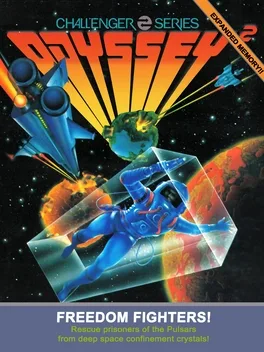
A shooting game featuring a Defender style left/right shooting ship. Enemies drift onto the screen with increasing speed, somewhat reminiscent of Geometry Wars.
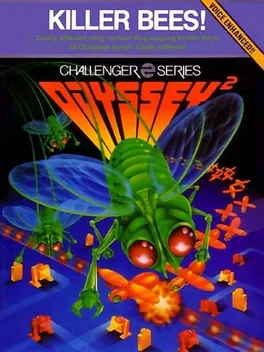
The Beebots from the insect civilization of BEM are invading the Earth, protected by swarms of Killer Bees, and it's up to a swarm of white bees to stop them. The player control the white bees swarm, trying to kill the Beebots by flying over them and stinging them. The longer the swarm flies over a Beebot, the slower it moves, until it finally stops and dies. When a Beebot dies, a grave marker will be raised in its place, making the movement of the remaining Beebots more difficult. The red Beebots move clockwise, the blue ones move counterclockwise.

You play a miner named Pickaxe Pete, and you start off in the middle of the screen with a pick-axe. There are three doors from which boulders are coming, bouncing down the mine-shafts; every time Pete destroys one of these he gains 3 points, although the axe wears out after a while and disappears. When two boulders collide, they explode, and out comes either a pick-axe which floats to the bottom of the screen, a key which floats to the top, or nothing. If Pete has no axe, you can either jump over boulders (gaining him 1 point), or get to the bottom of the mine to retrieve a new axe (gaining a 5-point bonus). If he collects a key then he can enter the doors, which lead him to the next level.
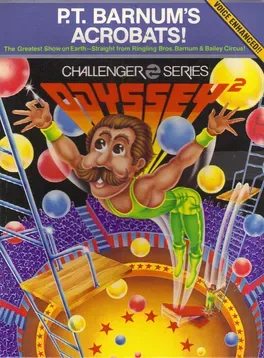
P.T. BARNUM'S ACROBATS! (1 or 2 players at a time) SINGLE PLAYER VERSIONS Press 0 on the numeric section of the keyboard. You are under the Big Top at the Ringling Bros. Barnum and Bailey Circus! One of the acrobats is standing on the platform at the left side of the screen. His partner is on the teeter board at the center of the screen. Three rows of balloons are dancing back and forth high above their heads. Use the joystick of the right hand control to move the teeter board from side to side. Use the action button to make the acrobat jump from the platform. If he lands on the high end of the teeter board, the other acrobat will fly into the air. (The closer the first acrobat lands to the high end of the teeter board, the higher the second acrobat jumps. If he does not jump high enough to reach the first row of balloons, he will crash.) If the flying acrobat hits a balloon it will pop and give him a bouncing chance to pop some others. Keep moving the teeter board so he lands on the high end when he finally comes down. A complete game is a series of ten jumps. The number of jumps left in the game is displayed at the lower center of the screen. Scoring: BALLOONS IN BOTTOM ROW - 2 POINTS BALLOONS IN MIDDLE ROW - 4 POINTS BALLOONS IN TOP ROW - 6 POINTS Your score is displayed at the lower right corner of the screen. Bonus scoring: ALL BALLOONS IN BOTTOM ROW - 15 POINTS ALL BALLOONS IN MIDDLE ROW - 20 POINTS ALL BALLOONS IN TOP ROW - 25 POINTS When all of the balloons in a row have been popped, a full row of new balloons will appear automatically. If you score over 999 (Nothing is impossible!), the counter at the lower right of the screen will start again at 000. A line directly over it will indicate you are working on your second thousand points! To play again, press any key except SPACE or RESET! Pressing SPACE will display the best score in a series of games at the lower left corner of the screen. Pressing RESET will permit entry of game variations. SINGLE PLAYER GAME VARIATIONS Stationary shield under moving balloons. Press 3. A shield will appear below the bottom row of balloons at the center of the screen. If an acrobat hits it he will thud to earth faster than he can holler for HELLLLLLPPPPPP! Random shield with moving balloons. Press 6. A shield will appear and disappear at random times and random positions below the balloons. Stationary balloons. Press 9. Stationary balloons with a stationary shield. Press C. Stationary balloons with a random shield. Press F. TWO PLAYER GAMES AND VARIATIONS In the first version, players alternate turns every time an acrobat misses the high end of the teeter board. The scoring indicators signal which of the hand controls is activated. If the right scoring indicator is lighted, the right hand control is activated and vice versa. Moving balloons - no shield. Press 1. Moving balloons with a stationary shield. Press 4. Moving balloons with a random shield. Press 7. Stationary balloons - no shield. Press A. Stationary balloons with a stationary shield. Press D. Stationary balloons with a random shield. Press G. In the second version, players take turns after each jump. Moving balloons - no shield. Press 2. Moving balloons with stationary shield. Press 5. Moving balloons with random shield. Press 8. Stationary balloons - no shield. Press B. Stationary balloons with stationary shield. Press E. Stationary balloons with random shield. Press H. Press SPACE after a game is over to recall the high score in a series. Press any key except SPACE or RESET to play another game of the same variation again. To play a different game variation, press RESET and then the appropriate key. SINGLE PLAYER GAME VARIATIONS Press 0: Moving balloons - no shield Press 3: Stationary shield - moving balloons Press 6: Random shield - moving balloons Press 9: Stationary balloons Press C: Stationary balloons - stationary shield Press F: Stationary balloons - random shield TWO PLAYER GAMES AND VARIATIONS Version I - Players alternate turns every time an acrobat misses the high end of the teeter board. Press 1: Moving balloons - no shield Press 4: Moving balloons - stationary shield Press 7: Moving balloons - random shield Press A: Stationary balloons - no shield Press D: Stationary balloons - stationary shield Press G: Stationary balloons - random shield Version 2 - Players take turns after each jump. Press 2: Moving balloons - no shield Press 5: Moving balloons - stationary shield Press 8: Moving balloons - random shield Press B: Stationary balloons - no shield Press E: Stationary balloons - stationary shield Press H: Stationary balloons - random shield

The player has just attracted the attention of Spyrus the Deathless, the Timelord of Chaos, and his only defense is his Time Machine's laser cannon. The Timelord will now send his fleet of Time Ships to destroy the player. In this space shooter the player controls the Time Machine horizontally with the directional stick and shoots its laser with the action button. The Timelord's Time Ships have four kinds of weapons to assault the player, and they will be introduced in the game's first four levels.

Scattered throughout the maze are boxes with question marks on them. When the player walks over a question mark, a baby turtle crawls onto the main turtle's back, a house will appear at a random location on the map, and the player will have to bring the baby turtle to its house while avoiding beetles. Other times, however, beetles will come out of the boxes, which the player will have to quickly run away from. The player's only offensive move is the ability to drop bombs (which behave more like mines) to temporarily stun the beetles. Additional bombs can be picked up in the middle of the maze. Each maze represents a floor of the building. After eight floors, there's a cutscene showing the baby turtles following their rescuer out of the building, and gameplay begins again on the ground floor.
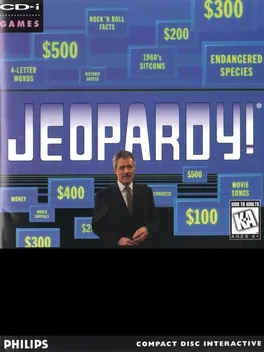
If you’ve always anted to be on Jeopardy! (and who hasn’t), play the world’s most popular ‘answer and question’ game and feel like you’re on the set! You’re standing in front of the cameras, hand at the buzzer, as host Alex Trebek calls you by name and peppers you with categories and dollar amounts. Win the most money, become champion and see your score immortalized in the Jeopardy! Hall of Fame. The unique response to directory on CD-I makes this version as fast-paced as the television game itself.
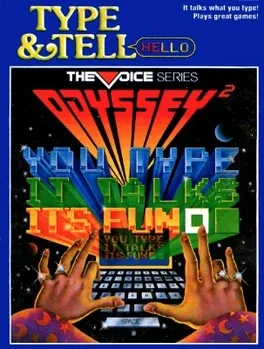
Type & Tell! lets the player type in a word or a message and then have the words spoken back to them by utilizing the Odyssey 2's voice module. The instruction manual suggests the following games that can be played: Garble! - Players take turns typing in one letter at a time, The idea is to form sentences by just using the sounds the individual letters make. Sound Waves! - Players type in random letters trying to create sounds that sound like something that could be heard in real life. Super Star! - Players can use the sounds or dialogue the game makes in their own home movie or radio show. War of Words! - This game requires at least two players. Player take turns typing in words until a sentence is created by one of the players adding a period. Players then take turns inserting words into the sentence, while trying to keep it grammatically correct. The first player to extend the sentence exactly to the end of the available typing space is the winner. If a player extends the sentence beyond the end of that available space, they lose.

Power Lords is a game released for the Odyssey 2. It is based on the toy line from the 1980s that bears this name. To start the game, press 1 on the keyboard. You have just arrived at Volcan Rock - an artificial planetoid defended by a laser-eyed space serpent and other minions of the evil Extra-Terrestrial Alliance! Use the joystick of the right hand control to fly the space sled. Press the action button to fire your lasers. Warning! Your space sled can be destroyed by falling lava, rocks, contact with the space serpent's body or a blast from it laser eyes. Gryptogg, Raygoth and Arkus of the Extra-Terrestrial Alliance, will periodically open doors in the volcano to fire a gravitational ray. The higher your score, the stronger the artificial gravity fields will become and the more likely you will be drawn to your doom. Direct hits of your lasers will stun the space serpent and destroy falling rocks. You can defeat the gravitational ray by blasting the door in the volcano. SCORING: - Blasting lava during volcanic eruption: 3 points - Stunning the space serpent: 15 points - Hitting an open door: 45 points - Destroying lava rock: 75 points - Surviving a volcanic eruption: 1000 points The score of your current game appears at the lower right of your screen. The high score in a series of games will appear at the lower left of your screen. Two question marks request the initials of the high scoring player. The high scoring player enters his or her initials through the keyboard. The high score and the high scoring player's initials will remain on the screen until a higher score is achieved in succeeding games. To start a new scoring round press RESET and then press 1.
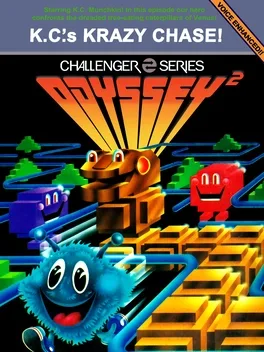
The sequel to the Odyssey 2's notorious Pac-Man clone, K.C. Munchkin!